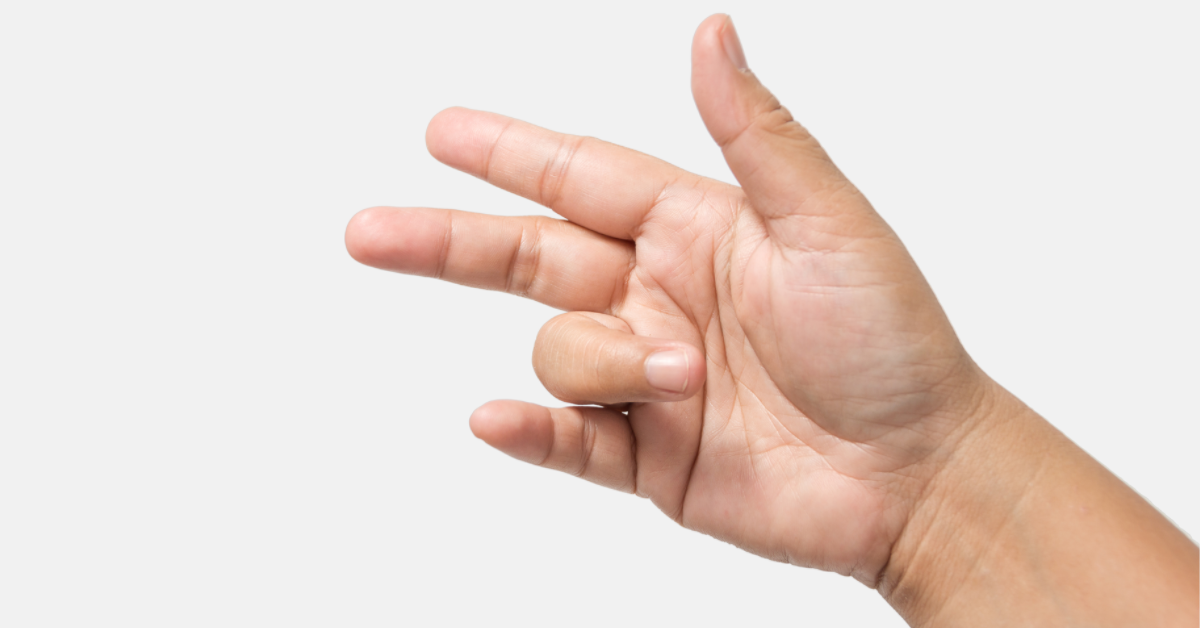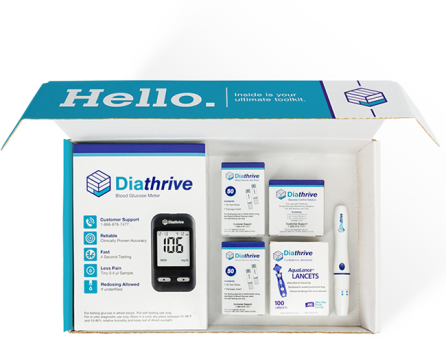
Have you noticed that one or more of your fingers hurts and sometimes get locked in position? If so, you might have trigger finger, and you have come to the right place to learn more.
In this article, we will learn what trigger finger is, explore why people living with diabetes are more likely to have trigger finger, and learn about symptoms and treatment for the condition.
What is Trigger Finger?
Your fingers move with the help of flexor tendons that connect to the muscles that are responsible for moving your fingers. Flexor tendons are surrounded by a flexor sheath that lubricates the tendon and allows for easy movement. If the sheath becomes irritated or inflamed, the tendon can no longer move smoothly.
When this happens, your finger may lock when you bend it and “click” when you straighten, with symptoms often worse in the morning. This lock and release of your finger is why the condition is called trigger finger.
Trigger finger usually starts out as discomfort in the palm of your hand when moving the affected finger, most often your ring finger. Early warning signs also include swelling, stiffness, or pain.
Over time, the flexor tendon is more and more constrained and you develop a painful click as you flex and extend your finger. Sometimes, the affected finger can even become locked in place. Swelling or redness in the entire finger can occur along with pain when moving the affected digit.
Although anyone can develop trigger finger, there are some differences in the presentation of the condition depending on whether or not you have diabetes. Women living with diabetes are more likely to develop trigger finger compared to women who do not have diabetes. Also it’s more common to have trigger finger in both hands and/or more than one finger if you are living with diabetes.
Risk Factors for Trigger Finger
The exact cause of trigger finger is not known, but there are certain risk factors that are associated with the condition. Overall, it is more common in people between the ages of 40 and 60 years.
Other risk factors include:
-
Diabetes and history of elevated blood glucose
-
Length of time living with diabetes
-
Previous occurrence of trigger finger in another finger
-
History of carpal tunnel syndrome
-
History of rheumatoid arthritis
-
Jobs like farming, musicians, industrial workers and others jobs that require repeated thumb and finger movements
Some risk factors are more significant than others. If you are living with diabetes and/or have carpal tunnel syndrome, you are twice as likely to develop trigger finger than someone who is not living with these conditions.
Studies have also shown that the incidence of trigger finger in people living with diabetes is four times as high as the general population, with even higher risk in people who are insulin-dependent. This condition affects about 10 to 20 percent of people with diabetes compared to only two or three percent of the general population. Having trigger finger in multiple digits was also associated with people who had been living with diabetes significantly longer than people with trigger finger in one digit.
So, why do people living with diabetes have a greater incidence of trigger finger? The cause is not clear, but trigger finger most often occurs in people with chronically high blood sugar. It is known that high blood sugar levels associated with uncontrolled or under controlled diabetes cause damage to organs and tissues in your body, including your joints. One theory is that trigger finger is associated with collagen build-up in tendon sheaths caused by chronic hyperglycemia (high blood sugar).
Treatment for Trigger Finger
Diagnosis of trigger finger is relatively simple and doesn’t require lab tests or x-rays. The same symptoms you are seeing are easily observed by your healthcare provider, so diagnosis usually only requires a physical examination. Your healthcare provider will take note of any swelling, bumps or nodules, and obvious locking of your finger(s).
The best treatment for trigger finger is rest for the affected digit. This is hard to do since using your hands is part of everyday life. Splinting the finger can help immobilize the joint so it can rest. Pairing this approach with anti-inflammatory medicines can correct the condition. Splinting may be needed for up to six weeks.
If splinting doesn’t work, there are other treatment options available. Treatment with steroid injections is an option, but this treatment can be problematic for people living with diabetes. Steroid therapy can increase blood sugar levels, and has not been shown to be effective in people with diabetes.
The good news is there are alternatives to steroid therapy including splinting/resting the affected finger as noted above, massage, physical therapy, and surgically correcting the locked tendon.
Surgery is a relatively simple procedure that takes about 20 minutes and has a high rate of success.
There are three types of surgery for trigger finger:
-
Open surgery which means the doctor makes an incision in the palm of your hand to access the tendon sheath. The sheath is then cut to allow the tendon to move freely again. You will have stitches in the palm of your hand after this procedure. This is the most common surgical procedure for trigger finger.
-
Percutaneous release surgery does not leave a wound. In this procedure, the doctor inserts a needle to cut the tendon sheath.
-
Tenosynovectomy is done most often on people who have rheumatoid arthritis which makes the first two options not suitable. This procedure involves removing a part of the sheath instead of cutting it.
When surgery is chosen as the treatment option, physical therapy is often needed to restore movement and strength in the affected finger.
Trigger finger is not an inevitable condition, and there are things you can do to prevent it, perhaps the best being to manage your blood sugar. If you have chronically high blood sugar, despite following your diabetes management plan, consult with your healthcare provider. Managing your blood sugar is essential for living a healthy life with diabetes.
Managing Blood Sugar
There are many things people with diabetes can do to help themselves keep blood glucose levels in a healthy range. Lifestyle strategies do not replace insulin or other medicines, but can help people with diabetes better manage their blood glucose levels.
Simple things like drinking water and exercising can help regulate your blood sugar. Dehydration means less water in your body, which also increases the concentration of glucose in your blood. Drinking water naturally hydrates your body and reduces the concentration of glucose in your blood. Exercise tells your body to turn sugar into fuel for your cells. Exercise works particularly well for people living with type 2 diabetes. If your circumstances make moderate or intense exercise difficult or impossible, increasing movement is still beneficial for your health. You can do things like walk the dog, work in your yard, park farther away from stores, basically anything that gets you moving.
Managing stress can also reduce blood glucose. Stress actually causes your body to make hormones that cause your blood glucose levels to rise. This is a natural reaction that gives you a burst of energy to deal with whatever is causing the stress. If your body doesn’t have adequate insulin to convert the glucose to energy, you may see a rise in blood glucose. Lack of sleep acts the same way as stress, telling your body to increase glucose in your blood. It’s not always easy to reduce stress, but strategies include doing things that ease your mind like walking, yoga, meditating, or just taking a break.
Managing the quantity and type of food you eat is probably the most often mentioned way to reduce blood glucose. Making changes like reducing the amount of table sugar, syrup and honey in your diet can help prevent high blood glucose. There are lots of other ways your diet can be slightly changed for the better, including limiting carbohydrates and increasing fiber. Studies show that a diet low in carbohydrates can help reduce blood sugar spikes.
Summary
Trigger finger is an uncomfortable condition that sometimes cannot be avoided. This condition is the result of inflammation in the sheath around your tendon. When this happens, your tendon cannot move freely, so your finger may lock and then click back straight when you move it.
There are risk factors that influence whether or not you develop the condition, including a history of diabetes and elevated blood sugar, history of carpal tunnel syndrome or rheumatoid arthritis, and even certain occupations.
If you are living with diabetes, you have a greater possibility of developing trigger finger.
Although the cause is not clear, trigger finger seems to be associated with high levels of blood glucose. Managing your blood glucose levels has been shown to reduce the possibility that you will develop the trigger finger.
Sources:
Trigger digits in diabetes: their incidence and characteristics | National Institutes of Health
DIABETES AND TRIGGER FINGER | Merivale Hand Clinic
Losing your grip: diabetes hand syndrome | Diabetes Voice
Trigger Digits and Diabetes Mellitus | National Institutes of Health




